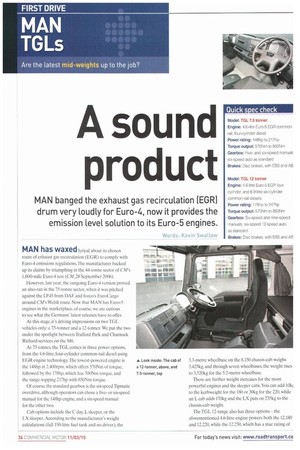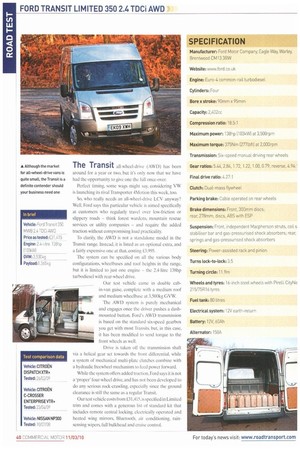A sound product
Page 36

Page 37

Page 40

Page 41

Page 42

If you've noticed an error in this article please click here to report it so we can fix it.
MAN banged the exhaust gas recirculation (EGR) drum very loudly for Euro-4, now it provides the emission level solution to its Euro-5 engines.
Vords: Kevin Sweltav MAN has waxed lyrical about its chosen route of exhaust gas recirculation (EGR) to comply with Euro-4 emissions regulations The manufacturer backed up its claims by triumphing in the 44-tonne sector of CM'S 1,000-mile Euro-4 test (CM, 28 September 2006).
However, last year, the outgoing Euro-4 version proved an also-ran in the 7.5-tonne sector, when it was pitched against the LE45 from DAF and Iveco's EuroCargo around CM's Welsh route. Now that MAN has Furo-5 engines in the marketplace, of course, we are curious to see what the Germans' latest releases have to offer.
At this stage, it's driving impressions on two TGL vehicles only: a 7.5-tonner and a 12-Lonner. We put the two under the spotlight between Trafford Park and Charnock Richard services on the M6.
At 75 tonnes, the TGL comes in three power options, from the 4.6-litre, four-cylinder common-rail diesel using EGR engine technology. The lowest-powered engine is the 148hp at 2,400rpm, which offers 570Nm of torque. followed by the 178hp, which has 700N m torque, and the range-topping 217hp with 850Nm torque.
Of course, the standard gearbox is the six-speed Tipmatic overdrive, although operators can chose a fiveor six-speed manual for the 148hp engine, and a six-speed manual for the other two.
Cab options include the C day. L sleeper, or the LX sleeper. According to the manufacturer's weight calculations (full 150-litre fuel tank and no driver), the 3.3-metre wheelbase on the 8.150 chassis-cab weighs 3,425kg, and through seven wheelbases, the weight rises to 3,520kg for the 5.2-metre wheelbase.
There are further weight increases for the more powerful engines and the sleeper cabs. You can add 1011 to the kerbweight for the 180 or 30kg for the 220, while an L cab adds 170kg and the LX puts on 235kg to the chassis-cab weight.
The TGL 12-range also has three options the aforementioned 4.6-litre engine powers both the 12.180 and 12.2211. while the 12.250, which has a true rating of 247hp with 1.000Nm torque, has a six-cylinder 6.9-litre common-rail diesel.
The six-speed Tipmatic serves the 180 and 220, while the 250 gets a 12-speed overdrive, with an option of a nine-speed manual overdrive, There are also the same three cabs, The 12.180 chassis-cab 5.2m wheelbase version weighs in at 3,885kg with the L cab, the 220 engine adds 20kg, and the 6.9-litre 250 engine put 200kg on the weight ticket.The L cab puts 170kg on and the LX another 235kg.
The version CM drove came with an optional 5.55metre wheelbase, which requires rear air suspension. As a chassis cab, it comes in at 3.605kg. With the XL cab that increases to 3,840kg before you add a well-proportioned driver and the body.
We drove the 12.250 first from Charnock Richard services, via Chorley, to Trafford Park. It's a well-driven route for the MAN TG family and allowed us to compare and contrast with the 18-tonner we drove previously.
The first standout point is the continuity with the rest of the MAN brand, Handling is similar, hut it's the 12-speed automated transmission that is central to the driving characteristics of the 12and 18-tonne MAN products.
These mid-weights are fast becoming popular in the UK. and MAN offers a strong enough product for it to be considered a contender. Handling, gear change, momentum, and comfort are all strengths.
The refinement of the 12-tonner made the transition to the 8.180 7.5-tonner a leap — a six-speed auto and a smaller engine capacity with less power. With a smaller chassis and less power. you can feel the weight as you drive. As a product. it is sound, and a transport manager won't regret purchasing a TGL 8.180, but MAN must concede it is unlikely to worry the Dutch or the Italians.
Automated transmission should help persuade operators to go for a clutch-friendly system, and the smoothness of the ride and drive will win over drivers.
The 178hp engine is the right option at 7.5 tonnes for local and multi-drop, but for up to the 18.7-tonne gross train weight (GTW) the 217hp engine might be in order. The Transit all-wheel-drive (AWD) has been around for a year or two, but it's only now that we have had the opportunity to give one the full once-over.
Perfect timing, some wags might say, considering VW is launching its rival Transporter 4Motion this week, too.
So, who really needs an all-wheel-drive LCV anyway? Well, Ford says this particular vehicle is aimed specifically at customers who regularly travel over low-friction or slippery roads — think forest wardens, mountain rescue services or utility companies — and require the added traction without compromising load practicality.
To clarify. the AWD is not a standalone model in the Transit range. Instead, it is listed as an optional extra, and a fairly expensive one at that, costing L1,995.
The system can be specified on all the various body configurations, wheelbases and roof heights in the range, but it is limited to just one engine — the 2.4-litre 138hp turbodiesel with rear-wheel drive.
Our test vehicle came in double cabin-van guise. complete with a medium roof and medium wheelbase at 3,500kg (NW The AWD system is purely mechanical and engages once the driver pushes a dashmounted button. Ford's AWD transmission is based on the standard six-speed gearbox you get with most Transits, but, in this case. it has been modified to send torque to the front wheels as well.
Drive is taken off the transmission shaft via a helical gear set towards the front differential, while a system of mechanical multi-plate clutches combine with a hydraulic freewheel mechanism to feed power forward. While the system offers added traction. Ford says it is not a 'proper' four-wheel drive, and has not been developed to do any serious rock-crawling, especially since the ground clearance is still the same as a regular Transit.
Our test vehicle costs from f.31,415, is specified in Limited trim and comes with a generous list of standard kit that includes remote central locking, electrically operated and heated wing mirrors, Bluetooth. air conditioning, rainsensing wipers, full bulkhead and cruise control.
Productivity
Of course, having the enhanced traction system is going tc have an impact on net payload, but it's not quite at much as you might originally think. Compared witt the standard rear-wheel-drive Transit, the additiona front-axle weight is just 50kg, so, on balance, the extra weight shouldn't really harm fuel consumption in driving conditions On the laden run, the Transit returned a respectable 26.9mpg, which might sound heavy, but it pips the VW Crafter CR35's figure of 29.4mpg, and that's a regular two-wheel-drive 3.5-tonner. After removing the ballast, the Ford upped its game signficantly on our Kentish test route around Kent, using just over 12.5 litres of fuel over the 90-mile course, whicl equates to approximately 32.1mpg.
With the second row of seats in place, you are losim a lot of load space, but with the medium roof, there'! still 5.7e-worth of load volume in the back of the van to fit shelves, tools or chainsaws. There's also robust chipboard and a non-slip protective covering in the load area, which is a must-have, especially since this van is likely to be operating in harsher environments. The rear doors open Fuel. consumption: out to a full 270 degrees at the touch of a button. and.
similar to all li-ansits, the load lip is low (700mm to be Lade26.9mpg 110.5dt/700km!
exact), which makes packing the vehicle a breeze. Unladen 32.1mpg (8.71.4/100km) On the road We already know what the Ford Transit is like on the road. having tested numerous iterations over the years. but we have never ventured on to the rough stuff with one„. until now, that is.
We evaluated the system on a muddy offroacl section at our test track with a full payload on board to sec if Ford's claims would stand up to scrutiny We first tried it in normal two-wheel-drive mode in order to obtain a benchmark, and while the van did make it out the other side, it was far from comfortable for vehicle and driver.
Since ESP is not available with all-wheel-drive Transits, the rear wheels on our vehicle spun wildly as they scrabbled for traction. Engaging the AWD system was an altogether different story.
The test van was fitted with regular Pirelli van tyres, but it didn't even struggle with the sloppy mud pools at the track, with the transmission sending torque to the front and back wheels, or whichever ones had the most grip.
This variation of the Transit is more than capable when the terrain starts to get rough, but don't think that you can go from London to Cape Town in it, because, while it might boast an all-wheel-drive set-up, it most certainty is not a four-wheel-drive van in the truest sense of the phrase.
We should single out the 138hp 2.4-litre engine for particular praise, because it serves up a generous spread of torque and it never wants for power — even up the 16% gradient of our Kentish hill with full payload. Cab comfort One of the biggest gripes we have concerning Transits is cab access. This is due to the fact that the front wheelarch humps intrude noticeably into the cabin. This happens on both sides of the vehicle.
We had a bench seat fitted to our vehicle, which provides seating for the driver and two passengers, but it's not what you'd call comfortable (except 14.)r the driver, that is).
The dash-mounted gearlever juts out quite far, leaving precious little legroom for the middle passenger. while the intrusive wheelareh means the far-left passenger can't sit with both of their feet on the floor.
Despite these negative points, the elevated driving position is a definite plus, offering a good view on or off the road. Anyone can fit comfortably into the driver's seat as it can be adjusted in just about any direction be it up, down, forwards and backwards. And it's a good reason the seats are so versatile, especially considering there's no steeringwheel adjustment.
The dashboard and controls are well laid out, hut we do feel it is starting to show its age, especially compared with the newly facelifted and revised VW Transporter.
There's absolutely loads of useful storage spaces in the cabin and we especially liked the twin-compartment door bins than can keep anything from juice bottles to A4 Illes.
In addition, there's the customary lidded gloveboxes on the dashboard that allow operators to keep valuables out of view. •








































































































































